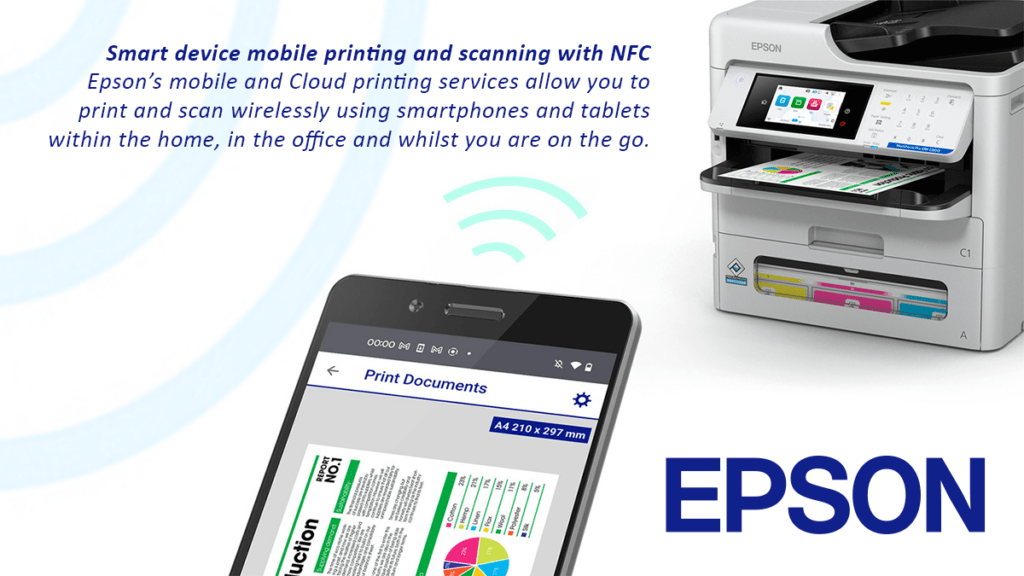Epson has launched its EM-C800RDWF and EP-C800RDW printers, which achieve highest ink yields for their segment, helping to the boost the efficiency and sustainability of the products.
Sustainability and efficiency are two watchwords for IT managers across the country, as budgets for many businesses remain tight, but they also look to make their technology as environmentally-friendly as possible, including printers.
To this end, Epson has launched its new Workforce Pro EM-C800RDWF multi-function product (MFP) and Workforce Pro EP-C800RDW single function printer. Both products are A4 and incorporate Epson’s Replaceable Ink Pack System (RIPS) to deliver high-capacity ink within a small product footprint, along with low power consumption and fast first-page-out speeds.
Developed using Epson’s Heat-Free inkjet technology, these printers require no heat in the print process and therefore consume less energy than comparable laser printers. It also means there is no warm-up time needed from sleep, delivering a first printed page in just 4.8 seconds when printing in mono.
With prints speeds of up to 25ppm, a paper capacity of up to 1,830 sheets with optional cassettes and an intuitive user interface, these printers are ideal for small workgroups with high print volume needs, either in small and medium business environments or as part of a larger corporate fleet.
The Workforce Pro EM-C800RDWF also offers scan, with duplex scan speed of up to 60ipm. And because both products are compatible with a wide range of Epson and select third party ISV solutions, they can be easily integrated into existing fleets, workflows and management systems.
Sustainability
Sustainability has been a big consideration with the printers. “One of the key aspects is that we’ve included an increased amount of recycled plastics within the device itself,” says Dan Wogan, product manager at Epson. “It has 30% recycled plastics, which have come from old IT equipment.
“In addition, we’ve got the latest version of our PrecisionCore print head, which makes that value proposition around really low energy consumption even stronger.
“The PrecisionCore print head produces droplets down a 10th the width of the human hair. So tiny, tiny little droplets, which means it is ridiculously efficient.”
Then there is Epson’s RIPS to deliver high-capacity ink. “Some of the key benefits here is that it reduces waste and lowers the number of interventions that need to be made with it,” says Dan. “When we speak to IT managers, generally, they aren’t big fans of printers. They’re probably one of the least complex items that sit on their infrastructure and yet, they get calls about them regularly, and it’s often just a bit of a pain for them.
“So that lack of intervention by having ink cartridges that will work for, in a normal print environment, months and months before they’re need replacing just reduces the hassle from an IT management perspective.”
Punching above its weight
Dan adds that the EM-C800RDWF and EP-C800RDW punch above their weight. “It only prints 25 pages per minute but the way most people use A4 desktop printers has always been to just print a handful of pages at any one time,” he says. “Three to four pages is the most common size print job. So not having that oven to warm up thanks to Epson’s Heat-Free technology means that the productivity is much quicker on this type of device. So even though it’s only 25 pages a minute, it punches well above its weight without batting an eyelid against up to 40 page a minute printers.
“Likewise, with most desktop A4 printers only printing up to 4,000 pages a month, and often lower than that, the fact that will likely require a couple of changes of supplies within its lifespan makes it attractive. There just aren’t those fusers or consumables to be changed, which means it saves on packaging and delivery costs. It’s just a much lighter touch.”
The printers also appeal to a broad range of customers. “We’ve got them sat everywhere from cruise ships to offices, individual offices to people working from home,” says Dan. “They’re small enough to sit in people’s home office or larger environments where there is more of a distributed print environment.”
Reseller conversations
When talking to resellers, Dan says that sustainability is a key benefit to emphasise and they can use Epson’s Optimisation Calculator to help with that, which can be used to calculate how much energy it will use and the savings it can make compared to other devices.
“The starting point of the conversation should be about the real value in our product is delivering a sustainability benefit to our end customer,” Dan says. “Many organisations that we speak to these days have got targets set and do want to make a positive impact from that perspective.
“Then there’s a range of solutions that these devices can be slotted into so they can fit at that small office or home office in a wide range of sectors.”
Dan adds that the low intervention nature of the product – through the heat-free technology and large ink capacity, as well as its reliability – should also be emphasised by partners. He adds that they are good for partners too working in managed print services as they do not have the volume of service interventions that they might find with other printers.
